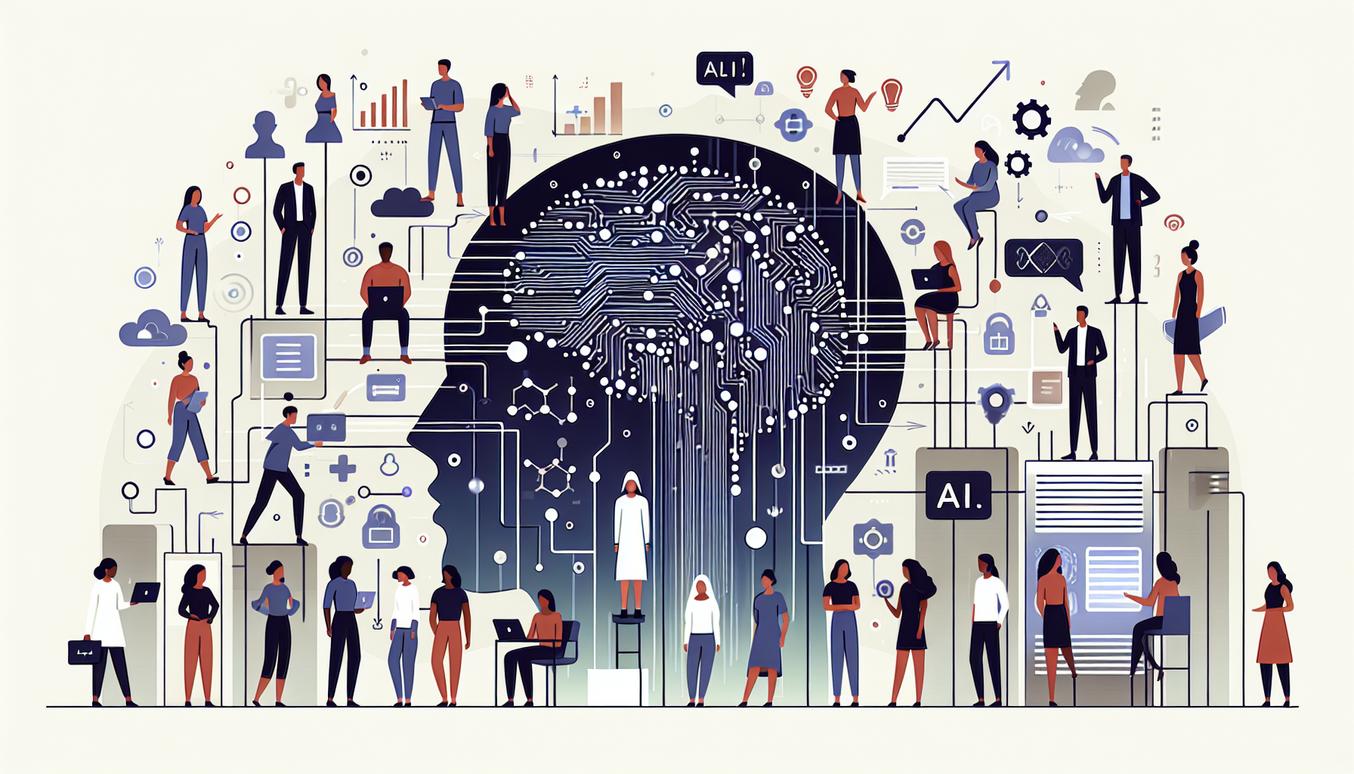Table of Contents
- What AI Innovation Means Today
- Translating Research into a Tactical Roadmap
- Core Technologies and Their Strategic Roles
- Experimentation Culture and Data Readiness
- Responsible AI Governance and Risk Controls
- Deployment Patterns and MLOps Considerations
- Measuring Impact: KPIs and Business Metrics
- Failure Modes and Recovery Patterns
- Implementation Playbooks: Three Practical Examples
- Roadmap Template and Next Steps
What AI Innovation Means Today
In the current landscape, AI innovation has evolved far beyond theoretical algorithms and research papers. It represents the pragmatic and scalable application of artificial intelligence to solve concrete business problems, drive efficiency, and create new value streams. The focus has shifted from asking “What can AI do?” to “What should AI do for our organization?” This involves a strategic fusion of cutting-edge technology, robust data infrastructure, responsible governance, and a culture that embraces iterative development. True AI innovation is not about isolated proofs-of-concept; it is about embedding intelligent, automated, and adaptive systems into core business processes in a way that is both measurable and sustainable.
For tech leaders and practitioners, this means navigating a complex ecosystem of models, platforms, and methodologies. The challenge lies in translating the potential of advanced AI into reliable, enterprise-ready initiatives. It requires a clear-eyed view of both the opportunities and the risks, ensuring that every AI project is anchored in strategic goals, governed by ethical principles, and designed for operational excellence. This guide provides a practical roadmap for achieving meaningful AI innovation in your organization.
Translating Research into a Tactical Roadmap
The journey from a groundbreaking research paper to a production-grade AI system is fraught with challenges. Academic breakthroughs often occur in controlled environments with clean data, a luxury rarely afforded in the real world. A tactical roadmap is essential to bridge this gap, providing a structured path for identifying, validating, and scaling AI opportunities. This roadmap must balance ambitious, long-term goals with near-term projects that deliver tangible value and build organizational momentum for AI innovation.
Prioritization Framework for Projects
Not all AI projects are created equal. A robust prioritization framework helps you allocate resources effectively by evaluating opportunities against key business and technical criteria. Before committing to a project, assess it across these four dimensions:
- Business Impact: How significant is the potential value? This could be measured in revenue growth, cost savings, risk reduction, or improvements in customer satisfaction. High-impact projects should align directly with strategic corporate objectives.
- Technical Feasibility: Do we have the skills, technology, and algorithmic approaches to solve this problem? This involves assessing the complexity of the model, the required computational resources, and the maturity of the underlying AI techniques.
- Data Readiness: Is the necessary data available, accessible, and of sufficient quality and quantity? Data is the lifeblood of AI, and its absence or poor quality is a common point of failure.
- Ethical and Operational Risk: What is the potential for unintended harm, bias, or regulatory non-compliance? What is the operational risk if the model fails? High-risk applications require stronger governance and human oversight.
Projects that score high on impact and feasibility with manageable data requirements and low risk are ideal candidates for initial investment. This systematic approach ensures that your AI efforts are focused where they can make the most difference.
Core Technologies and Their Strategic Roles
Understanding the core technologies driving modern AI is fundamental to building a strategic portfolio. Each technology serves a different purpose, and the most powerful solutions often combine them. True AI innovation comes from matching the right tool to the right problem.
Neural Networks and Deep Learning in Practice
At the heart of many recent breakthroughs, Neural Networks and deep learning excel at identifying complex patterns in large datasets. Their ability to learn from unstructured data like images, text, and sound makes them invaluable for a wide range of tasks.
- Strategic Role: Automating perception and prediction tasks at scale.
- Practical Applications: Predictive maintenance in manufacturing (analyzing sensor data to forecast equipment failure), customer churn prediction (identifying patterns in user behavior), and medical image analysis.
Generative Models and Responsible Use
Generative AI models create new content—from text and images to code and synthetic data. While immensely powerful for creativity and augmentation, their use demands strong ethical guardrails to prevent misuse, misinformation, and the generation of biased content.
- Strategic Role: Augmenting human creativity, automating content creation, and generating synthetic data to train other models.
- Practical Applications: Assisting developers with code generation, creating marketing copy and designs, and producing anonymized, realistic datasets for model training in privacy-sensitive domains.
Reinforcement Learning and Decision Automation
Reinforcement Learning (RL) trains agents to make optimal sequences of decisions by rewarding desired outcomes. It is ideal for dynamic environments where the rules are complex or constantly changing.
- Strategic Role: Optimizing complex, multi-step processes and automating decision-making in real-time.
- Practical Applications: Dynamic pricing for e-commerce, optimizing logistics and supply chain routing, and controlling robotic systems in manufacturing and warehouse automation.
Experimentation Culture and Data Readiness
Successful AI innovation is not born from a single monolithic project; it is cultivated through a culture of continuous experimentation. Tech leaders must champion an environment where teams are empowered to test new ideas, fail quickly, and learn from their results. This agile approach allows organizations to rapidly validate hypotheses and pivot without incurring massive costs.
This culture, however, is powerless without a solid foundation of data readiness. This goes beyond simply having data; it means having high-quality, accessible, and well-governed data. Key pillars of data readiness include:
- Robust Data Pipelines: Automated, reliable systems for ingesting, cleaning, and transforming data from various sources.
- Centralized Feature Stores: Repositories for storing and managing curated data features, ensuring consistency and reusability across different models and teams.
- Strong Data Governance: Clear policies on data quality, privacy, security, and lineage, ensuring that data is used responsibly and effectively.
Responsible AI Governance and Risk Controls
As AI systems become more autonomous and impactful, implementing a framework for Responsible AI is no longer optional—it is a prerequisite for long-term success and public trust. Governance should not be an afterthought but an integral part of the AI development lifecycle. The goal is to proactively manage risks rather than reactively addressing failures.
A strong governance framework is built on three core principles:
- Fairness: Actively identifying and mitigating unwanted bias in data and models to ensure equitable outcomes across different user groups.
- Accountability: Establishing clear ownership and responsibility for AI systems, including their decisions and impacts.
- Transparency: Making AI systems understandable to stakeholders. This includes documenting data sources, model architectures, and decision-making logic, often referred to as “explainability.”
Practical controls include conducting bias audits, implementing human-in-the-loop review processes for high-stakes decisions, and maintaining detailed logs for model behavior and versioning.
Deployment Patterns and MLOps Considerations
A model is only valuable once it is deployed in production and integrated into business workflows. The discipline of Machine Learning Operations (MLOps) provides the principles and tools to do this reliably and at scale. MLOps automates and standardizes the entire machine learning lifecycle, from data preparation to model deployment and monitoring.
Monitoring, Drift Detection, and Model Maintenance
Deploying a model is the beginning, not the end. The real world is dynamic, and a model’s performance will inevitably degrade over time as the data it encounters in production diverges from the data it was trained on. This phenomenon is known as model drift.
An effective MLOps strategy must include robust monitoring for:
- Data Drift: Changes in the statistical properties of the input data (e.g., a shift in customer demographics).
- Concept Drift: Changes in the underlying relationship between input features and the target variable (e.g., changing consumer preferences).
- Operational Health: Monitoring for technical issues like latency, throughput, and error rates.
Automated alerts for drift and performance degradation should trigger a predefined process for model retraining, validation, and redeployment, ensuring the system remains accurate and reliable.
Measuring Impact: KPIs and Business Metrics
To secure ongoing investment and demonstrate value, it is critical to connect AI performance to tangible business outcomes. While data scientists focus on model-centric metrics like accuracy or precision, business leaders care about Key Performance Indicators (KPIs). The success of your AI innovation strategy depends on your ability to translate one into the other.
Create a clear mapping between technical metrics and business KPIs. Here is an example:
| AI Use Case | Model Metric | Business KPI |
|---|---|---|
| Predictive Maintenance | Model Precision and Recall | Reduced Equipment Downtime (%) and Lower Maintenance Costs ($) |
| Customer Churn Prediction | F1-Score | Increased Customer Retention Rate (%) |
| Fraud Detection | False Positive Rate | Reduced Fraud Losses ($) and Improved Customer Experience |
Failure Modes and Recovery Patterns
Even with robust testing and monitoring, AI systems can fail. A mature AI strategy anticipates these failures and designs resilient systems that can recover gracefully. Proactively identifying potential failure modes is a critical risk management exercise.
Common failure modes include:
- Edge Case Failures: The model encounters rare or unforeseen input data, leading to unpredictable outputs.
- Silent Failures: The model produces incorrect results without triggering any technical errors, often due to subtle data drift.
- Biased Outcomes: The model systematically produces unfair or discriminatory results for a particular demographic group.
Effective recovery patterns include:
- Fallback Mechanisms: If a model’s confidence score is too low or it fails, the system automatically reverts to a simpler, rule-based model or flags the case for human review.
- Graceful Degradation: Designing the system to continue functioning with reduced capability rather than failing completely.
- Rapid Rollback: Using MLOps automation to quickly and safely redeploy a previous, stable version of the model if the new one causes issues.
Implementation Playbooks: Three Practical Examples
Theory is best understood through application. Here are three high-level playbooks illustrating how these principles of AI innovation come together in different industries.
- Predictive Maintenance in Manufacturing: An industrial company aims to reduce costly unplanned downtime. They use sensor data (vibration, temperature) to train a deep learning model that predicts equipment failures. The model is integrated with their maintenance system, automatically generating work orders for at-risk machines. The KPI is a reduction in unscheduled downtime, measured in hours.
- Personalized Customer Experience in Retail: An e-commerce platform wants to increase customer engagement. They leverage Natural Language Processing (NLP) to analyze product reviews and a reinforcement learning model to dynamically personalize product recommendations. The system is monitored for fairness to ensure it does not create filter bubbles. The KPI is an increase in conversion rate and average order value.
- Diagnostic Imaging Assistance in AI in Healthcare: A healthcare provider seeks to support radiologists by accelerating the review of medical scans. A computer vision model is trained to identify and highlight potential anomalies in X-rays. This system acts as a “second pair of eyes,” flagging scans for priority review by a human expert. The KPI is a reduction in diagnostic turnaround time while maintaining accuracy.
Roadmap Template and Next Steps
Building a sustainable engine for AI innovation requires a structured, phased approach. Use this template to guide your strategic planning for 2025 and beyond.
- Phase 1: Ideation and Prioritization (Quarters 1-2):
- Establish a cross-functional AI steering committee.
- Identify and document potential use cases across business units.
- Apply the prioritization framework (Impact, Feasibility, Data, Risk) to select the top 2-3 pilot projects.
- Define clear success metrics and business KPIs for each pilot.
- Phase 2: Prototyping and Validation (Quarters 2-3):
- Assemble dedicated project teams with data scientists, engineers, and domain experts.
- Develop proof-of-concept models to validate technical feasibility.
- Conduct rigorous testing and bias assessments.
- Present initial findings to stakeholders to secure buy-in for production.
- Phase 3: Productionalization and MLOps (Quarters 3-4):
- Build robust MLOps pipelines for automated training, deployment, and monitoring.
- Integrate the model into a target business process with clear fallback mechanisms.
- Launch the solution in a limited capacity (e.g., A/B test or to a small user group).
- Phase 4: Scaling and Governance (Ongoing):
- Monitor model performance and business impact continuously.
- Scale the solution based on validated results.
- Codify learnings into a central playbook for future AI projects.
- Continuously refine your Responsible AI governance framework.
The field of AI is constantly advancing. The key to lasting success is to build an organizational capability—combining technology, people, and processes—that can adapt and harness the next wave of AI innovation. By following this pragmatic roadmap, you can move beyond the hype and deliver real, measurable value to your enterprise.









